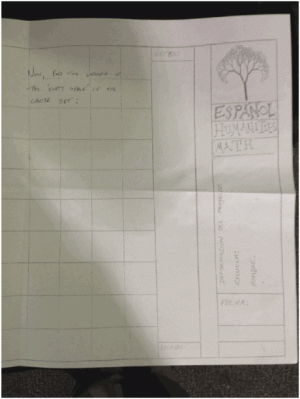Reframing and Refining the Worksheet
Worksheets matter! I know we hear a lot of talking points that tell us to get rid of them, but I think it's much more complicated than that. That call for "no more worksheets" comes from a place where that is all there is. By that I mean classrooms where students do nothing but worksheets. Often these worksheets are de-contextualized from relevant work, and this is where there's an opportunity to reframe and refine the traditional worksheet. There is a time and place for drill and practice or individual practice -- even in a PBL project. The key is to make it appropriate and relevant.
A recent visit to a PBL school jumpstarted my brain on this issue. I had the pleasure of visiting the ACE Leadership Academy in Albuquerque, New Mexico. Here students work collaboratively on PBL projects that focus on Architecture, Construction and Engineering. The projects are relevant, and students are partnering with local companies and organizations to make them happen. During the visit, I had the chance to watch students at work.
Worksheets That Model a Career Tool
Students consistently worked on a piece of paper shown below. This paper looked similar to a tool that architects or construction workers use. Now, while this might be used for drafting a building plan (and in fact it was), it was also used for doing practice math problems, for annotating texts and for other instructional practices. When I talked with students, some mentioned they liked working on the same sheet. "It feels more real," one said. "It helps to remind me why I do the work."
As we design worksheets, let's consider making them look like the real-world work that students are doing -- or could be doing. Although it might be considered an aesthetic change, it did help bring relevance to work that is often decontextualized. The worksheet itself helps to build the culture of relevance and real-world connection.

Other Tips for Worksheets
Include the Driving Question Where Students Can See It
Like changing the look of the worksheet, this piece may seem too simple to make a real change. However, we know that if the driving question is present during a PBL project, it can be a great engagement tool. Effective PBL teachers have students reflect and unpack the driving question throughout the PBL project. As that question captures the purpose of the work, why not have it present on a worksheet? Presence of purpose can create relevance and engagement.
Rubric and Reflection
Remember that a rubric can actually be just another quality indicator. For worksheets that focus on small, more discrete skills, consider including those corresponding rubrics on the worksheet. This lets students see how to meet and exceed a standard. Even if a rubric is not appropriate to the worksheet, have students reflect and set goals for improving, or simply celebrate their learning. This will help them know exactly what they've learned and see the next steps.
Scaffolding the Levels of Questions
Often, the questions we ask students about a piece of content or text are not ordered in a way that can help scaffold their thinking. Start with more identification and comprehension questions, and move through inference, evaluative and predictive questions. Students will be able to handle the "cognitive load" because the questions scaffold the thinking needed to answer the bigger questions. Use Costa's Levels of Questions to help.
While these are technical and aesthetic changes to the worksheet, it is more critical that teachers continually connect the daily work to the authentic task or project through discussion, metacognition and reflection. These changes to the way we design and use worksheets are just some of the ways that great teachers are using a variety of teaching tools to engage our students.
